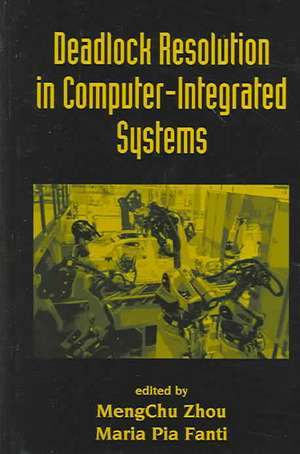Deadlock Resolution in Computer-Integrated Systems
Editat de MengChu Zhou, Maria Pia Fantien Limba Engleză Hardback – 27 dec 2004
Deadlock Resolution in Computer-Integrated Systems is the first text to summarize and comprehensively treat this issue in a systematic manner. Consisting of contributions from prominent researchers in the field, this book addresses deadlock-free models and scheduling, detection and recovery methods, the formulation of dynamic control policies, and comparison and industrial benchmark studies that evaluate various approaches. The editors lay the foundation for exploring deadlock issues with a typical example of an automated manufacturing process, illustrating three primary modeling methods (digraphs, Petri nets, and automata) and comparing their respective advantages and disadvantages.
Providing all of the important models and resolution approaches, this book is the complete guide for electrical and control engineers and manufacturing, intelligent, and network systems designers to prevent and manage deadlock issues in their systems.
Preț: 1206.93 lei
Preț vechi: 1794.21 lei
-33% Nou
Puncte Express: 1810
Preț estimativ în valută:
230.95€ • 246.96$ • 192.56£
230.95€ • 246.96$ • 192.56£
Comandă specială
Livrare economică 28 martie-11 aprilie
Doresc să fiu notificat când acest titlu va fi disponibil:
Se trimite...
Preluare comenzi: 021 569.72.76
Specificații
ISBN-13: 9780824753689
ISBN-10: 0824753682
Pagini: 696
Ilustrații: 263 b/w images, 38 tables and 263 halftones
Dimensiuni: 156 x 234 x 40 mm
Greutate: 1.11 kg
Ediția:New.
Editura: CRC Press
Colecția CRC Press
ISBN-10: 0824753682
Pagini: 696
Ilustrații: 263 b/w images, 38 tables and 263 halftones
Dimensiuni: 156 x 234 x 40 mm
Greutate: 1.11 kg
Ediția:New.
Editura: CRC Press
Colecția CRC Press
Public țintă
ProfessionalCuprins
List of Contributors. Preface. Introduction to Deadlock Research in Computer-Integrated Systems. Deadlock Avoidance in Automated Manufacturing Systems Using Finite Automata and State Space Search. Synthesis of Deadlock-Free Supervisory Controllers Using Automata. Deadlock Avoidance and Dynamic Routing Flexibility in Automated Manufacturing Systems. Digraph-Based Techniques for Deadlock Resolution in Automated Manufacturing Systems. Deadlock-Free Supervisory Control for Assembly and Disassembly Systems. Deadlock Avoidance Algorithms and Implementation: A Matrix Based Approach. Deadlock Detection and Prevention of Automated Manufacturing Systems Using Petri Nets and Siphons. Siphon-Based Characterization of Liveness and Liveness-Enforcing Supervision for Sequential Resource Allocation Systems. Elementary Siphons of Petri Nets for Efficient Deadlock Control. Resource-Oriented Petri Nets in Deadlock Prevention and Avoidance. The Effect of Modeling and Control Techniques on the Management of Dead-locks in FMS. Deadlock Characterization and Resolution in Interconnection Networks. Deadlock Models for a Multi-Service Medium Access Protocol Employing a Slotted Aloha or Q-ary Tree Based Signaling Channel. Deadlock-Free TCP Over High-Speed Internet. Deadlock Resolution in Large-Scale Internet Computing. Models Used in Static Analysis for Deadlocks of Ada Tasking Programs. Deadlock Handling in Database Systems. Index.
Descriere
Deadlock Resolution in Computer-Integrated Systems is the first text to summarize and comprehensively treat this issue in a systematic manner. Consisting of contributions from prominent researchers in the field, this book addresses deadlock-free models and scheduling, detection and recovery methods, the formulation of dynamic control policies, and comparison and industrial benchmark studies that evaluate various approaches. The editors lay the foundation for exploring deadlock issues with a typical example of an automated manufacturing process, illustrating three primary modeling methods (digraphs, Petri nets, and automata) and comparing their respective advantages and disadvantages.
